Johns Hopkins: Facebook, Social Media Campaign Boosted Organ Donation

Facebook is perfect for sharing photos, funny life updates, and...organs? Giving people the opportunity to list their organ donation status led to precipitous jump in registered donors, according to findings published today in the American Journal of Transplantation.
The initiative was the brainchild of Dr. Andrew Cameron, a transplant surgeon at Johns Hopking University, and his Harvard classmate Sheryl Sandberg, the current Facebook chief operating officer. They came up with the plan during their 20th college reunion in 2011. Sarah Feinberg and Mark Zuckerberg were also key players in the final implementation of the program.
The idea was simple: let people announce whether or not they are organ donors on Facebook and provide information on where they can register. Facebook is the most popular social media platform in the U.S., with over 150 million active users, so Cameron and Sandberg reasoned it could provide a significant boost to organ donor registration.
Nearly one-third of Americans (~100 million people) are currently registered organ donors, the highest level in U.S. history. Despite this large donor pool, the number of actual transplants - 30,000 per year - is dwarfed by the number of patients on waiting lists in need of new organs: 105,000 individuals.
This shortfall is due to many factors. A deceased body is hard to preserve, and a person must die in a certain way to donate their organs. A potential donor must also die near or at a hospital. Sometimes doctors don't have the appropriate consent, like when a person isn't carrying their donor card or if family members are unaware the deceased's final wishes.
In the end, this leaves about 10,000-15,000 possible donors per year.
Focused recruitment efforts are viewed as a possible method to improve transplantation rate, but donor registration has plateaued in recent years.
In May 2012, Facebook allowed users of its new 'Timeline' feature to post their organ donation status for the first time. NPR reported that this led to 275,000 members posting their donor status over the course of four months.
In this study, Cameron and colleagues report that, within the first month of the new policy, there was a huge surge in donors who signed up with state registries and Donate Life America.
There were 13,000 new online registrants on just the first day. This amounted to a 21-fold increase nationwide. Georgia witnessed the biggest jump on the first day, with 109 times more donors than normal signing up.
Over the course of a fortnight, 40,000 new donors were recorded, which was 33,000 more than what would have been expected for this time period.
"The short-term response was incredibly dramatic, unlike anything we had ever seen before in campaigns to increase the organ donation rate," said Cameron. "And at the end of two weeks, the number of new organ donors was still climbing at twice the normal rate,"
While this pace slowed over the following two weeks, the researchers witnessed a 6-fold increase for the month of May 2012.
"If we can harness that excitement in the long term, then we can really start to move the needle on the big picture," said Cameron. "The need for donor organs vastly outpaces the available supply and this could be a way to change that equation."
Cameron and Facebook officials are now discussing a possible relaunch of the program on its mobile platform or offering incentives, such as coupons, to users who update their organ donor status.
Cameron concluded: "This was the first effort like this designed to mobilize people for a public health cause. Now we want to build on that. Studying the response to the organ donor effort is the next step in the process of using social media for social good."
Source: Cameron AM, Massie AB, Alexander CE, et al. Social Media and Organ Donor Registration: The Facebook Effect. American Journal of Transplantation. 2013.



























